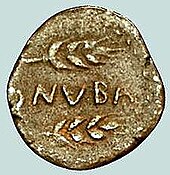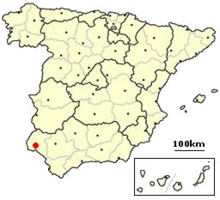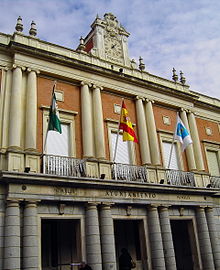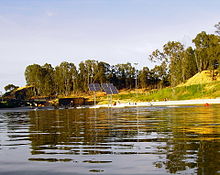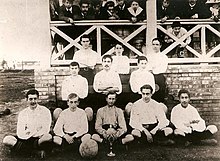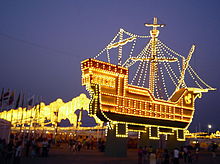Huelva
| Huelva municipality | ||
|---|---|---|
| coat of arms | Map of Spain | |

|
|
|
| Basic data | ||
| Autonomous Community : | Andalusia | |
| Province : | Huelva | |
| Comarca : | Comarca Metropolitana de Huelva | |
| Coordinates | 37 ° 15 ′ N , 6 ° 57 ′ W | |
| Height : | 54 msnm | |
| Area : | 149 km² | |
| Residents : | 143,663 (Jan 1, 2019) | |
| Population density : | 964.18 inhabitants / km² | |
| Founding: | 10 century BC | |
| Postal code : | 21001 - 21007, 21070, 21071, 21080 | |
| Municipality number ( INE ): | 21041 | |
| administration | ||
| Mayor : | Pedro Rodríguez González ( PP ) | |
| Website : | www.huelva.es | |
| Location of the municipality | ||

|
||
Huelva [ ˈwelβa ] is the capital of the province of Huelva in southwestern Andalusia with 143,663 inhabitants (as of 2019). In contrast to the other coastal cities of Andalusia, the city is hardly touristy. The largest employer is the chemical industry area in the east of the city.
Origin of name
The oldest tradition of the name Onuba comes from the Phoenicians and is therefore around 3000 years old. The background of the word is probably the connection of Onos Baal (strength of Baal ). Even today one can derive the Spanish name for Huelvaner or Onubense from Huelva from it. The Greeks kept the name stem and adjusted it to Ὄνοβα . Under the Romans , Onoba Aesturia became part of the Baetica Province . By diphthongizing the initial / O / to / Hue / and the assimilation of the / n / to the preceding vowel to / l /, Onuba became the current name of Huelva. The Moors already knew the city by this name, which they usually rendered as Walbah . Other sources speak of Gaelbah and Umba . The inhabitants of Huelva are known as huelveños or more commonly as onubenses .
Geography and nature
The city is located on the four-kilometer-wide estuary of the Odiel and the Río Tinto , which flow here into the Atlantic Ocean . The climate is particularly mild.
The urban area also includes the 7000 hectare nature park Marismas del Odiel , with the protected areas Reserva del Burro and Reserva de la Isla de Enmedio . Many species of birds have nesting places there.
climate
| Huelva (19 m) | ||||||||||||||||||||||||||||||||||||||||||||||||
|---|---|---|---|---|---|---|---|---|---|---|---|---|---|---|---|---|---|---|---|---|---|---|---|---|---|---|---|---|---|---|---|---|---|---|---|---|---|---|---|---|---|---|---|---|---|---|---|---|
| Climate diagram | ||||||||||||||||||||||||||||||||||||||||||||||||
| ||||||||||||||||||||||||||||||||||||||||||||||||
|
Average monthly temperatures and rainfall for Huelva (19 m)
|
||||||||||||||||||||||||||||||||||||||||||||||||||||||||||||||||||||||||||||||||||||||||||||||||||||||||||||||||||||||||||||||||||||||||||||||||||||||||||||||||||||||||||||||||||||
In October 2005, near Huelva, Hurricane Vince hit the Iberian Peninsula for the first time since 1842 . However, since it was a small, weaker hurricane, there were no deaths or injuries.
history
Archaeological finds from Huelva and the surrounding area show that probably as early as the late 10th, but at least since the early 9th century BC. BC, trade contacts with the Phoenicians existed and it is even assumed that Tartessos was located at this place . From the time between approx. 900 and 770 BC During excavations from 1998 in the vicinity of the Plaza de las Monjas, objects made of silver, copper, iron, ivory and stone, as well as many thousands of fragments of clay pots were found. Of the latter, only a small part - around 8,000 - have been cataloged. Among these were over 3,000 ceramic fragments of the Phoenician type, but also 33 specimens of Greek- geometric ceramics came to light. In addition, isolated shards from Cyprus and sardines were found. Although indigenous finds are the most common, due to the high proportion of Phoenician goods, it is assumed that Huelva was a very early Phoenician emporion . It was a prosperous city under the Carthaginians and Romans , who started mining ore. The city came to a standstill under the Visigoths and Arabs, from whom the city was recaptured in 1257 by Alfonso X the Wise.
The city has only recently developed; In 1880 it only had 13,000 inhabitants. It owes its upswing to the mineral deposits on the Rio Tinto ( Minas de Riotinto ) and in Minas de Tharsis ( copper , iron , sulfur and manganese ).
From Huelva, Christopher Columbus set sail for America.
Few historical monuments have been preserved, such as the Roman aqueduct that still supplies the city with water today.
The Lisbon earthquake
On November 1, 1755 at 10:00 a.m., a severe earthquake (magnitude 8.5 on the Richter scale ) occurred with the epicenter near Lisbon. The quake lasted about six minutes and destroyed large parts of the Iberian Peninsula. Eight people died in Huelva and much of the buildings were destroyed. Including the monastery of La Merced, the church of San Pedro, the conception church and the castle. Overall, the damage was so great that one can speak of a rebuilding of the city.
British Influence 1873–1954
Since the last quarter of the 19th century, the city turned into a small British colony. The reason for this was the permission of the Spanish government in 1873 that the mines of Riotinto could be developed and used economically by the Rio Tinto Company Limited . As a result, the city and its infrastructure began to grow, and the sleepy little village became a modern industrial city of the 19th century.
Among the new buildings were, for example, railway facilities with the train station that still exists today and a loading quay in the harbor basin (see picture). The connection to the rail network allowed the arrival of new workers (mainly from Andalusia , Extremadura and Galicia ) and an expansion of the city. The districts of Las Colonias and El Matadero emerged near the wetlands ( Marisma ). Due to the development, the cityscape changed significantly. The Casa Colón (built in 1880) and the Barrio Reina Victoria (1914) are evidence of this period . Since the nationalization of the mining company (1954) and the mining crisis of the last few decades, this era is largely a thing of the past in the city and province of Huelva.
The British also brought football to Spain, which in 1889 led to the creation of the first football club - Recreativo Huelva - in Spain.
Politics and administration
The city is home to two administrations with different levels of competencies and responsibilities.
- The provincial administration of the province of Huelva , with its chairman Doña Petronila Guerrero (PSOE), responsible for the administration and organization of the provincial affairs, as well as the coordination of the municipalities in the province. Located on Avenida Martín Alonso Pinzón (Grand Vía) in the city center (currently being renovated (as of Jan 2008)).
- The municipality of Huelva which is responsible for the administration of the city's public affairs. Chairman is the mayor, since the municipal elections in 1995 Pedro Rodríguez González (PP)
The 2007 municipal elections resulted in the following distribution of seats in the town hall:
List of mayors since 1979
| mayor | Political party | From | To |
|---|---|---|---|
| José Antonio Marín Rite | PSOE | 1979 | 1988 |
| Juan Ceada | PSOE | 1988 | 1995 |
| Pedro Rodríguez González | PP | 1995 | 2015 |
| Gabriel Cruz Santana | PSOE | 2015 |
Demographics
Huelva has a population of 143,663 people (as of January 1, 2019). The population development in the past shows a strong increase from the time the mines opened in the 19th century and the construction of the chemical plants in the 1960s.
In 1787 the city had 5,377 inhabitants, in 1857 8,519. At the end of the 1880s, the population began to rise sharply. In 1887 they doubled to 18,195 in just 30 years. In the first years of the 20th century the number rose to 21,359 inhabitants, forty years later to 56,427. In 1960 74,384 people were registered, ten years later, when the first chemical plants were built, 96,689. Another increase in population followed. 127,806 inhabitants in 1981 and 144,479 in 1991.
| 1842 | 7.173 | 1992 | 142,809 |
| 1857 | 8,519 | 1993 | 144.008 |
| 1860 | 9,805 | 1994 | 145.049 |
| 1877 | 13,215 | 1995 | 145.712 |
| 1887 | 18.195 | 1996 | 140,675 |
| 1900 | 21,359 | 1998 | 139.991 |
| 1910 | 29,072 | 1999 | 140,583 |
| 1920 | 34,327 | 2000 | 140.985 |
| 1930 | 44,872 | 2001 | 141,334 |
| 1940 | 56,427 | 2002 | 140,862 |
| 1950 | 63,642 | 2003 | 144.831 |
| 1960 | 74,384 | 2004 | 144,369 |
| 1970 | 96,689 | 2005 | 145.150 |
| 1981 | 127,806 | 2006 | 145.753 |
| 1991 | 144,579 | 2007 | 146.173 |
economy
The city's economic activity is closely linked to the chemical industry, fishing and the service sector.
Primary sector
The town's fishery products are sold all over Spain. The fishing boats mainly bring prawns, lobsters and lobsters ashore. In addition to these higher quality products, sea bream, bream, tuna and plaice are also fished. The region around Huelva is Europe's largest producer of strawberries. In addition, many farmers make a living from growing lemons and oranges and from raising cattle.
Secondary sector
The chemical plants near the city (more precisely in Palos de la Frontera ) cannot be overlooked. Depending on the wind direction, there is often (due to the main wind directions more frequent in winter) unpleasant odors from the paper mill. It is said that the cancer rate in Huelva is the highest in Spain, but no connection with pollution has yet been established. To the east of the city there are large fields with phosphorus gypsum deposits. Depending on the source, the quality of the drinking water is given as heavy metal and highly dangerous or completely okay. According to a decision by politicians, the operating permit for the chemical plants should not be extended in a few years. But even the unions are up against it, as it is the largest employer in the region.
The operators of the chemical plants include Atlantic Copper, Air Liquide , Fertiberia and Fertinagro. The ENCE Energía y Celulosa operates in two major biomass power plants with 50 MW and 40 MW.
Tertiary sector
Within the service sector, tourism traditionally plays an unusually subordinate role in Huelva for Andalusia. In recent years, however, the number of visitors has risen continuously, not least because the pollution of the chemical industry has fallen sharply since Spain joined the EU. Furthermore, a kind of “industrial tourism” has established itself in Huelva. The conversion of the Casa Colon into a congress center, the development of the university and the annual film festival are further attractions, especially for business travelers. For some time now, the city has also been using the new motto “Huelva, la capital del Atlántico” (Huelva, the capital of the Atlantic) to draw attention to the history of the city, which is closely linked to the sea and the discovery of America do.
Infrastructure
The cityscape of Huelva appears very modern due to the wide streets, the tall houses and the large parks.
traffic
Rail transport
Huelva has a train station from which the Altaria train serves the capital Madrid once a day . There are also regional train connections to Seville and Zafra , each of which is served three times a day. A connection to the Spanish high-speed network AVE is planned, but fails because it would have to build through the Doñana National Park. There used to be a rail connection via Ayamonte to Portugal ( Linha do Algarve there ), but it has been closed and dismantled.
The train station is also called “Estación de Sevilla” (Seville train station) because until a few years ago there were two train stations in Huelva, each named after its direction. At the site of the former “Zafra” train station, there is now a district and the bus station of the same name. A new cross connection north of the city will introduce the Huelva – Zafra line to today's station.
The train station and the track systems were previously used to load raw materials onto ocean-going ships. Some evidence of this can be seen on the city map. An old loading pier has been made accessible to pedestrians and is a very nice place.
The idea of a tram concept has appeared in public discussion for several years . So far, however, there are no concrete implementation plans.
Bus transport
Huelva has a public bus system which consists of 9 lines, most of which are ring lines . A single trip costs 1.10 euros, with a prepaid system (“bono bus”) you get 10 trips for 6.50 euros. However, changing trains is not allowed. The buses run from around 7:00 a.m. to around 10:30 p.m. No timetables are posted at the stops, but the buses run every 10 to 15 minutes during rush hour. The transport company EMTUSA is responsible for the operation of the 37 buses, 35 of which are in use at peak hours according to the timetable.
The Damas company offers a good network of regional buses . Many destinations can be reached cheaply from the bus station in the city center. Some destinations, for example Seville (8.62 euros), Punta Umbría (1.55 euros), are served every hour.
port
The port of Huelva is the second largest port in the country after Barcelona . It is divided into two main areas: the inner harbor ( Puerto Interior ) and the larger outer harbor ( Puerto Exterior ), which, strictly speaking, is largely located in the municipal area of Palos de la Frontera .
The inner harbor is located on the lower reaches of the Odiel and consists mainly of the quay of the east wind ( Muelle de Levante ), which dates from 1972 and replaced the port facilities from the first decade of the 20th century. Due to its central location in the city and the shallow draft (only 6 m), mainly fishing companies have settled here. There is also a landing stage for authorities ( Guardia Civil and Coast Guard). There is also the quay of the boats ( Muelle de las Canoas ), from where a ferry leaves for Punta Umbría in summer . A little further north are the Huelva ( Astilleros ) shipyards , which traditionally manufacture fishing boats. At the southern end there is another large industrial area with port facilities, which extends from the stadium to the Columbus statue. The outer port of Huelva was built in 1965 and completes the industrial plant, which also dates from this period. It begins at the confluence of the Río Odiel and Río Tinto and extends almost to Mazagón , 11 km away , where one of the two port exits is located. The outer harbor mainly loads bulk goods and petroleum , most of which is still processed on site. A car and railway bridge over the Río Tinto connects the outer port with the city and the other port facilities. A second port exit leads through the marshland ( Marisma ) near Punta Umbría into the sea. From the time when the British mainly used the port for transport, the two former quays can still be seen: The Riotinto quay (named after the company, not after the river, as it is also in the Odiel river) , which is accessible again today, as well as the Kai Tharsis, which can be seen on the other side of the Odiel. This is in great danger of collapsing and cannot be entered.
air traffic
The nearest airports are Seville and Faro (Portugal) , both around 80 km away. There are discussions about whether it makes planning and economic sense to build an airport in Huelva. There are plans for this. Areas south of Gibraleón and another slightly north of Lepe are under discussion as possible locations . Initial proposals near Almonte or south of Valverde no longer appear in the current discussions, as they would affect military airspace on the one hand and Doñana National Park on the other. Charter flights are being considered as a potential clientele of the airport , which are primarily intended for city dwellers and weekend vacationers. Many of the surrounding golf courses would benefit from this. Also under discussion are cargo flights from Huelva to Moscow to supply an as yet undeveloped rich Russian upper class with fresh strawberries. It is also hoped that business aviation will be brisk with positive consequences for the region's economic development.
Public facilities
Museums
- Museo Provincial
- with departments of archeology and fine arts. Large collection of objects of Tartess origin and from the dolmen culture. Paintings from different artists and eras, but above all Vázquez Díaz.
- Columbus Museum in La Rabida with three replicas of Columbus' ships
university
The University of Huelva was founded in the mid-1990s and is still under construction in many places. Approx. 10,500 students were enrolled in the 07/08 winter semester, including around 220 Erasmus students from almost all EU countries.
The university's tenet is: Universitas Onvbensis Sapere Avde (University of Huelva, dare to use your wits)
The offer of the university includes:
- Polytechnic University
- Nurse training
- Social work
- Educational sciences
- Work sciences
- Economics
- Experimental science
- law Sciences
- Human sciences
Green spaces
- Park Moret : with 17 hectares the largest urban park in Andalusia. Equipped with barbecue areas, children's playgrounds, restaurant (in planning), skate track and artificial lake. With a wonderful view of the Marisma de Odiel .
- Park Alonso Sanchez : Located near the city center, from here you have a fantastic view over the city to the industrial plants and Punta Umbría.
Sports
Soccer
-
Recreativo Huelva (from Spanish Club Recreativo , to German "Erholungsverein") plays in the Segunda División B Group IV, similar to the third division in Germany, ie the third highest Spanish division. It is the oldest Spanish football club still in existence, founded in 1889 (in the Casa Colón ), which is why it is also known as Decano in addition to the acronym Recre . The Nuevo Colombino stadium is located on the banks of the Rio Odiel, near the center of the city.
 Nuevo Colombino Stadium , main stand
Nuevo Colombino Stadium , main stand
basketball
- The now dissolved basketball club CB Ciudad de Huelva played one season in the highest Spanish basketball league, the ACB league . With Club Baloncesto Huelva la Luz there has been a new basketball club in the city since 2008.
Other sports clubs
- Real Club Recreativo de Tenis de Huelva (Tennis) (founded in 1890 and therefore the oldest tennis club in the country)
- Real Club Marítimo de Huelva (sailing and oars)
- Club Rugby Tartessos Huelva (Rugby)
- Aguas de Huelva de Voley (volleyball)
- Club Rítmico Colombino de gimnasia rítmica (gymnastics)
- Club Esgrima Huelva (fencing)
- Huelva Sailors de Fútbol Americano (American Football)
- CB IES La Orden (Badminton) (highest Spanish league)
- Club Deportivo Masterhuelva (swimming)
- Judo Club Torii (Judo)
Attractions
- Statue of Christopher Columbus At the eastern end of the city, on the Punta del Sebo headland , a statue designed by the American sculptor Whitney was erected in honor of Columbus in 1929 . It is a gift from the American state to the Spanish people. The statue stands exactly where the Rio Tinto and Rio Odiel flow together. Not far from here, Columbus set off for India and discovered America. The statue faces south, today's port exit. Columbus, however, took an old port exit that no longer exists in a westerly direction. There are figures carved in the stone at every corner of the statue. Including the Mexican kings, the Spanish crown and the Catholic Church.
- Bullring
- The Mercado El Carmen could be visited until September 2008 . Fishermen in particular offered their goods here every morning (no fresh fish on Mondays). But strawberries, citrus fruits, bread and meat could also be bought here. The oldest market in Huelva (built in 1868) was closed in autumn 2008 and replaced by the new building opposite the main post office. A representative Plaza Mayor (main square) was built in place of the old market .
- Every Friday morning there is a flea market ( rastro ) in front of the Nuevo Colombino stadium . Migrants in particular offer their goods here; mostly very low quality at reasonable prices.
Churches
- La Merced Cathedral : construction began in 1605 and converted into a cathedral in 1953, only completed in 1970. Particularly interesting are the elegant facade, a woodcut of the Cristo de Jerusalem and the statue of the Virgen de la Cinta , patron saint of the city, probably from Montañes. The extension, which is now used as a university campus, was formerly a covent, later a hospital. Every hour on the hour, the bells of the Fandango Cathedral , a regional variant of flamenco, strike
- San Predro Church: (15th - 16th centuries) It was built on the remains of an originally Mudejar mosque; later some changes were made in the baroque style, such as: B. the tower. It is the oldest church in the city.
- Concepción Church; Built in the 16th century and rebuilt in 1755 after the Lisbon earthquake, this appears to be the first church in Spain to be dedicated to the Immaculate Conception of Mary. Inside you can see several paintings by Zurbarán as well as magnificent choir stalls.
- Sanctuary of Nuestra Señora de la Cinta ; 15-18 Century. The most beautiful church in the city, with a few decorative tiles reminiscent of Columbus, who thanked the Lord here for his healthy return after his first trip to America.
Places
- Plaza de las Monjas : Until the earthquake in 1755, the nuns' square was the convent's vegetable garden. The traditional bullfights were later held here. Today the square is one of the city's central meeting places. Since the 2006 renovation, it has been in full splendor and has a municipal tourist information office.
- Plaza de la Palmera : This was the meeting point of the city as far back as the Roman times. Today mainly a meeting place for young people. Many bars and restaurants are nearby.
The Roman Huelva
There is not much left to see from Roman Huelva.
- At the (northwest) entrance to the Campus del Carmen, ancient Roman finds can be viewed in a monument.
- In the city center near the Plaza de las Monjas, in the Sfera fashion store, excavations from Roman times can be viewed through a bulletproof glass floor.
The British industrial Huelva
- Reina Victoria working-class district ( Barrio Obrero ): groups of single-family houses in the English architectural style. Was built in 1917 by the old mining company Rio Tinto Company Limted for its workers and mostly English engineers. The quarter was surrounded by a wall and a security guard until the 1970s to protect the wealthier (now mostly Spanish) residents. At that time there was also a complete infrastructure of its own, such as grocery stores, administration, kindergarten, school and a soccer field.
- Casa Colón : Also built by the old mining company, the company's administration and headquarters were located here. The building, which dates from the 1870s, is now used as a congress center and event location and was also walled up until 15 years ago.
- Muelle Tinto : The Tinto quay in the city's harbor also bears witness to the industrial past. An old loading quay was restored and made accessible here in 2007. The construction used to be used to load minerals and mined raw materials from railway wagons onto ships. The quay is named after the Río Tinto company and not after the Río Tinto and is actually located on the Odiel River .
Tourist information
- A tourist information office of the Junta de Andalucía (regional government of Andalusia) with information about Huelva and all of Andalusia can be found in the city center opposite the Gran Teatro. Plaza Alcalde Coto de Mora 2. Opening times Mon – Fri 9 am–7.30pm / Sat, Sun, public holidays 10 am–2pm
- The city's tourist information center is located in the Plaza de las Monjas. Open only in summer.
- There is another tourist information center opposite the El Corte Inglés shopping center , near the Barrio Obrrero.
Nearby
- Punta Umbría
- Coto de Doñana National Park
- Minas de Riotinto
Culture
Holidays and regular events
- The carnival in Isla Cristina and Ayamonte is very famous , where the traditional groups called comparsas and chirigotas have their own style, different from the carnival in Cadiz . This style is also celebrated in Huelva. On Carnival Saturday there is a parade in the city center followed by a celebration on Avd. de Andalucia.
- The Semana Santa ( Holy Week ) is in the provincial capital, as in all other Andalusian cities, the biggest festival of the year.
- There are numerous pilgrimages ; the most important of all Andalusia is only a few kilometers from Huelva, in El Rocío (Pentecost).
- In the last week of July and the first week of August, the Fiestas Colombinas take place, celebrations in honor of Christopher Columbus .
- On September 8th, the patron saint Virgin de la Cinta is celebrated.
- The Ibero-American Film Festival takes place for one week in December.
Twin cities
language
A dialect of Andalusian is spoken in Huelva . English is also spoken in restaurants and hotels, but the majority of Spaniards only have a basic knowledge of English. German , French , Russian and Portuguese are offered in language courses, for example at the university, but here too there is usually only basic knowledge.
media
Four regional daily newspapers are published in Huelva:
- Huelva Información
- Odiel Información
- El Mundo Huelva Noticias
- Viva Huelva (free)
There are also various TV channels with regional editions of the city and region:
- Teleonuba
- Canal Noticias Huelva (CNH)
- Antena Huelva
- CRN Atlántico Televisión
In general, radio plays an important role in Spain. Some national stations broadcast regional versions for the province of Huelva, and there are also a number of regional radio stations, including the following:
- Hispanidad Radio (101.8)
- Odiel Radio (104.1)
- RNE (88.0 y 95.2)
- Cadena Ser (98.1)
- Cadena COPE ( MW )
- Canal Sur (97.3 and 104.5)
- Onda Cero (101.2)
- Melodia FM (89.9)
sons and daughters of the town
- Abū ʿUbaid al-Bakrī (1014-1094), Andalusian geographer and historian
- José Luis Gómez (* 1940), actor and director
- Martirio (* 1954), singer
- Trinidad Bonachera (* 1961), cultural scientist
- Carlos Longo (* 1982), badminton player
- Rocío Márquez (* 1985), flamenco singer
- Carolina Marín (* 1993), badminton player
Trivia
The man who never was
- → Military description in the article by HMS Seraph
- → Film adaptation: The Man Who Never Was (1956)
In 1943 there were also some agents from Nazi Germany in Huelva , as General Franco continued to sympathize with the Axis powers and thus did not behave neutrally. The German campaign in Africa was lost and the Allies were able to force the German-Italian forces there to surrender on May 13th . The next logical step was an Allied invasion of the difficult-to-defend southern Mediterranean flank of the Axis . This fact was of course known to the German defense long before the defeat in Africa. So the question was not whether the Allies would attack in southern Europe , but where exactly.
Against this historical background, at the end of April 1943, a Spanish fisherman found a body in the water off Punta Umbría . The body wore a Royal Marines uniform and was named Major William Martin . German members of the Wehrmacht examined the body and documents that it was carrying. These documents showed details of the attack by Allied forces in the Balkans and Sardinia .
After the information had been sent to the headquarters in Berlin, Hitler arranged for several units to be withdrawn from Sicily , where the Allies had previously been expected to land. A short time later, on July 10, 1943, it turned out that this original information was correct and that a maneuver had been deceived.
There are various assumptions about the origin of the corpse. The most widespread version says that it was a Welsh tramp, more recent information according to a sailor who drowned in the sinking of the HMS Dasher . According to other reports, it was a Portuguese fisherman who was found dead by the HMS Seraph , appropriately groomed and, calculated, thrown into the water off the coast of Huelva. The grave in which the body of the fictional Major William Martin rests is still in the Huelva cemetery today.
For decades, the grave was found covered in flowers in late summer. This mystery remained unsolved for a long time until it was discovered in the 1990s that a daughter of a British soldier who died in the war in Huelva was using this grave to mourn her father, whose body was never found. Every year on his birthday she came to the cemetery and decorated the grave. For these decades of service she was awarded the British Medal of Merit.
literature
- José Manuel García Gómez : Huelva. Row: Guias Everest. Editorial Everest, Madrid 1983. In Spanish. German edition: ISBN 978-84-241-4467-8
Web links
Sources and individual references
- Junta de Andalucia, Empresa Publica de Turismo de Andalucia, Huelva Guia Practica
- Andalusian Statistics Institute
- ↑ Cifras oficiales de población resultantes de la revisión del Padrón municipal a 1 de enero . Population statistics from the Instituto Nacional de Estadística (population update).
- ↑ Vaquero, JM, R. García-Herrera, D. Wheeler, M. Chenoweth et al. (2008): An Historical Analogue of 2005 Hurricane Vince , in: Bulletin of the American Meteorological Society , 89, pp. 191-201. See also Vaquero et al. (2008): Severe weather event in Iberia related to a Hurricane in 1842. EMS8 / ECAC7 Abstracts, Vol. 5, EMS2008-A-00197 (PDF; 117 kB)
- ↑ Fernando González de Canales Cerisola: Del Occidente Mítico Griego a Tarsis-Tarteso - Fuentes escritas y documentación arqueológica. Madrid 2005, ISBN 978-84-9742-344-1 .
- ^ F. González de Canales, L. Serrano, J. Llompart: El Emporio Fenicio-Precolonial de Huelva, approx. 900–770 aC BABesch 81, 2006, pp. 13–29.
- ↑ Población de hecho según el Instituto Nacional de Estadística de España. Alteraciones de los municipios en los Censos de Población desde 1842, Series de población de los municipios de España desde 1996 ( Memento of April 18, 2010 in the Internet Archive ). Data from 1787 come from the Floridablanca Census, available under Población de los municipios de Andalucía según los censos de 1787 a 2001. Junta de Andalucía. ( Memento from September 29, 2007 in the Internet Archive )
- ↑ Alteraciones de los municipios en los Censos de Población desde 1842. Huelva , National Statistical Institute, August 2, 2008.
- ↑ Population from 1986 to 1995 ( Memento of the original from November 16, 2010 in the Internet Archive ) Info: The archive link was inserted automatically and has not yet been checked. Please check the original and archive link according to the instructions and then remove this notice. , National Statistical Institute, September 2, 2008.
- ↑ Numbers since 1996 ( Memento of the original from June 28, 2011 in the Internet Archive ) Info: The archive link was automatically inserted and not yet checked. Please check the original and archive link according to the instructions and then remove this notice. , National Statistical Institute September 2, 2008.
- ↑ Facilities , on www.ence.es ( Memento of the original from October 6, 2018 in the Internet Archive ) Info: The archive link was inserted automatically and has not yet been checked. Please check the original and archive link according to the instructions and then remove this notice. , accessed October 5, 2018
- ↑ Visiting Spain news. ( Memento of the original from November 9, 2007 in the Internet Archive ) Info: The archive link was automatically inserted and not yet checked. Please check the original and archive link according to the instructions and then remove this notice.


